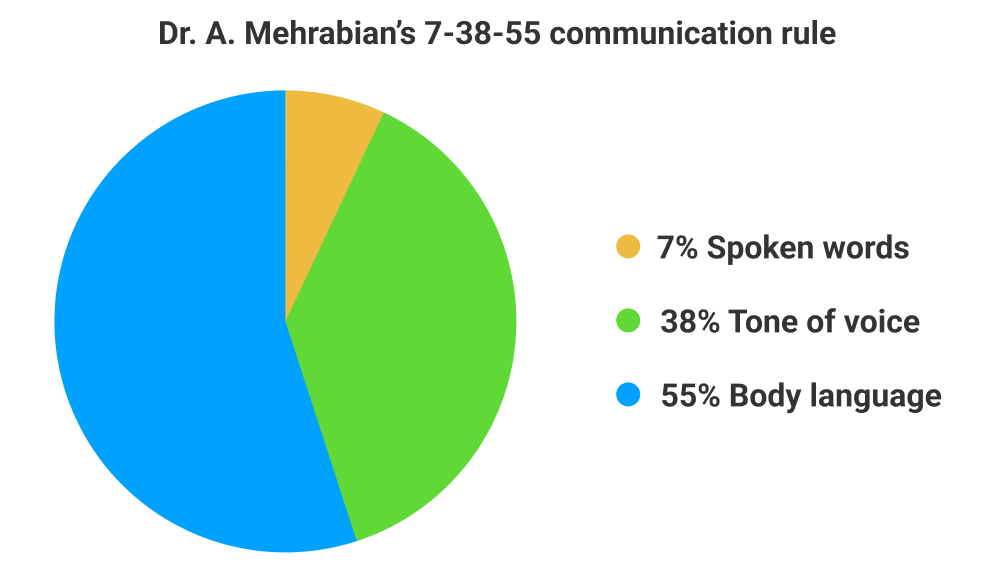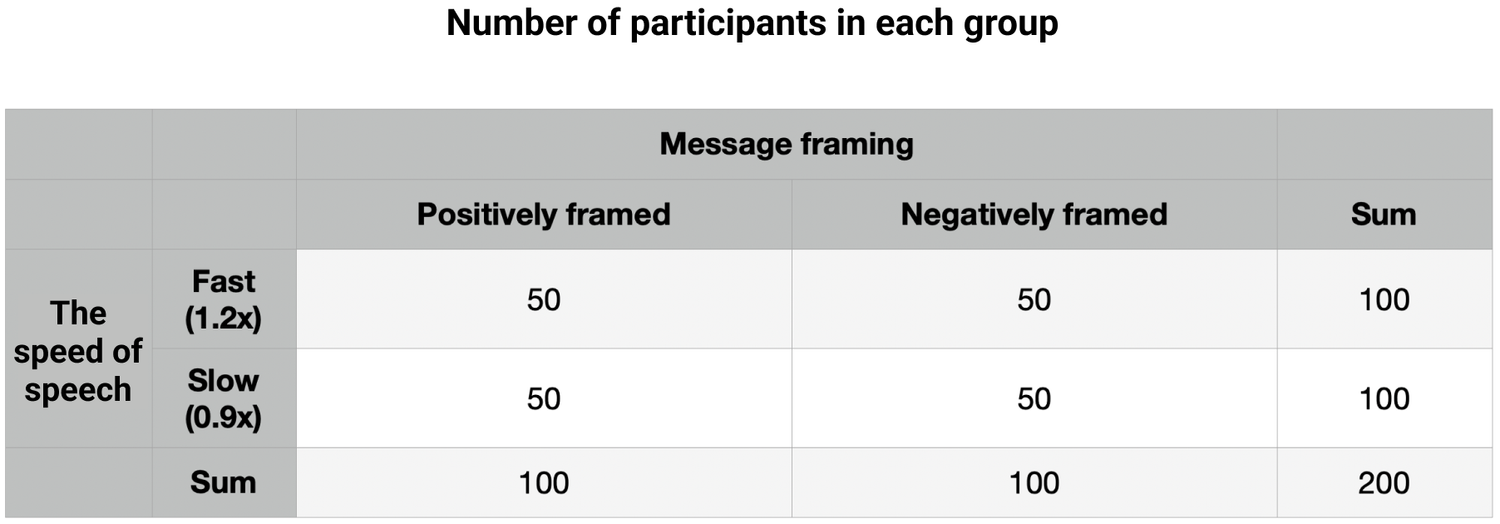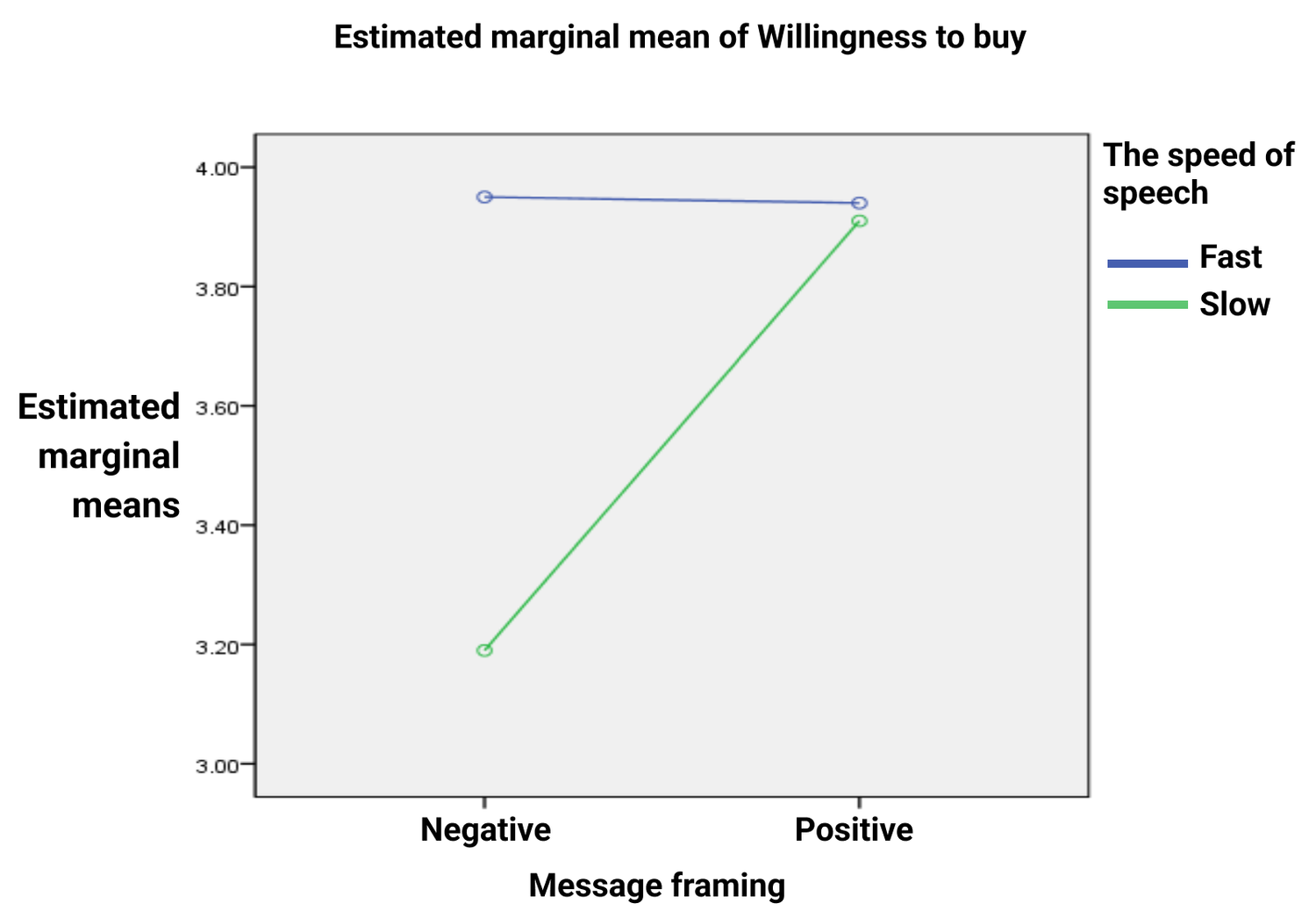
The Art of Persuasion
Project Overview
Project TypeResearch project
RoleResearch, Experiments, Data analysis
Time2018 (3 months)
ToolsSPSS
DescriptionThe Art of Persuasion is a research project about how to make a public speech more persuasive focusing on a speech speed and word-framing. The team hypothesised that a fast speech speed and negative message framing (or a combination of both) would increase persuasion. However, after the experiment and analysis, the team found neither had a statistical significance in influencing on the persuasion.
Research Process

* This is a Social Psychology project for my Bachelor's degree dissertation.
Mark: A+ (Equivalent to First Class degree)
Research Objective
The main objective of this research is to figure out what clues would make a speech more persuasive, especially when it comes to a sales speech.
Background Research
People are more influenced by nonverbal clues than by spoken words according to a psychology professor Albert Mehrabian [1]. Based on findings from several research, he formulated the 7-38-55% rule; When people speak to others, only 7% of meaning is delivered through verbal language, 38% through the tone and pitch of voice, and 55% through body language. It means that how people present their content is more critical than the content itself. Got insights from this research, my team wanted to find specific nonverbal clues that make one’s speech more persuasive.

Hypotheses
First hypothesis:If a salesperson’s speech speed is fast, consumers’ willingness to buy would be higher.
Second hypothesis:If a speech (message) is framed in a negative way, consumers’ willingness to buy would be higher.
Third hypothesis:There would be an interaction effect between the speed of speech and message framing.
Hypotheses Background
All the hypotheses are constructed based on solid research.
Research about Consumers’ Willingness to Buy“Willingness to buy” is a consumer’s behavioural dimension that is influenced by a salesperson’s persuasion [2]. This can predict whether a consumer actually purchases an item or not. Generally, the higher a consumer’s willingness to buy, the more chance he/she actually buys it. It is a proper scale to measure the effectiveness of sales techniques [3].
Research about the Speed of SpeechAmong various speech factors like the tone of voice, accent, etc., pitch and speed are two main factors that listeners perceive the most [4] and the team focused on the speed. A listener tends to think a speaker is not sincere when the speed of speech is slow [5]. Also, Blandy and Street stated that a high-speed speech can be more persuasive because listeners don’t have enough time to fully comprehend the content [6]. Specifically 1.5x faster than normal speed can make the most significant result. When it comes to South Korean, the slow speed is 96 words per minute (wpm), 108 wpm is normal, and 124 wpm is fast (in English, the normal speed is 125-190 wpm and 250-275 wpm is the most persuasive speed).
Research about Message FramingMessage framing is about highlighting a message either in positive aspects (i.e., benefits or advantages) or negative aspects (i.e., losses, risks). And the way in which a message is framed affects the level of persuasion. It is because consumers set a baseline of their willingness to buy based on how the message is framed [7]. And according to Prospect theory (figure below), consumers make a decision considering potential benefits and losses. When they listen to positively framed messages, they consider the benefits they would get, when they hear negatively framed ones, they think of the loss. Generally, people tend to have a more loss aversive attitude [8].

About Interaction EffectFrom research on the speed of speech and message framing, the team made another hypothesis that two variables can be combined in one speech. Thus, a salesperson can deliver a negatively framed message at a fast speed, and that would affect consumers’ willingness to buy.
Research
Preparation
The team planned to conduct an experiment to test the hypotheses. Since there are two variables (speech speed and message framing), we needed four groups: Fast and positive, fast and negative, slow and positive, and slow and negative. We recorded positively framed messages and negatively framed messages with a support of a speech expert. The speech speed of each file is 100 Korean words per minute. We recruited 50 participants for each group (a total of 200) considering their demographics and played the recorded file to each group.
(Translated transcript) Hello, this is Hanseul Park from Haneul home shopping. Today, I brought a portable power bank here that enables you to use your mobile devices longer. With a 10000mAh capacity, it can fully charge a mobile phone twice. A cable and a manual are included. Another selling point of this item is the size and weight. It has a small, 7x12cm of a handy size and 100 gram of very lightweight. Currently, the price is ₩25,000 (£15) in stores, but today you can get 20% off. So if you buy it now you will save ₩5,000 (£3). Again, if you buy it today, you will save ₩5,000 (£3). Call right now.
(Translated transcript) Hello, this is Hanseul Park from Haneul home shopping. Today, I brought a portable power bank here that enables you to use your mobile devices longer. With a 10000mAh capacity, it can fully charge a mobile phone twice. A cable and a manual are included. Another selling point of this item is the size and weight. It has a small, 7x12cm of a handy size and 100 gram of very lightweight. Currently, the price is ₩25,000 (£15) in stores, but today you can get 20% off. So if you don't buy it now you will lose ₩5,000 (£3). Again, if you don't buy it today, you will lose ₩5,000 (£3). Call right now.
Experiments
The first group heard a positively framed message file at a speed of 1.2x. The second group heard negatively framed messages at 1.2x speed. For the third group, they listened to positively framed messages at 0.9x speed. The last group heard negatively framed speech at 0.9x speed.

Participants were not aware of these variables, and they are randomly assigned to each group. After they heard the recorded file, they were asked to fill out a questionnaire. Then they were informed of detailed information about the experiment.
Analysis
Data Analysis
Data from the experiment is analysed by the Two-way ANOVA statistics method. The main effect of each variable - the speed of speech and message framing - didn’t show significant results considering the degrees of freedom, F ratio and p-value (The degrees of freedom of the speech speed is 1, F ratio is 1.719 and the p-value is .193. The degrees of freedom of message framing is 1, F ratio is 1.389, and the p-value is .242). The interaction effect also didn’t show significant results either (The degree of freedom is 1, the F ratio is 1.468, and the p-value is .229).

The team doubled the sample size to check whether we could get valid results or not. We assumed that we didn’t get a significant result because the sample size was too small. This second analysis, however, also didn’t show significant results either. Neither the main effect of each variable nor the interaction effect.
Conclusion
The hypotheses were refuted. The speed of speech and message framing don’t have a significant influence on persuasion. They don’t have a significant interaction effect either.
Reflection
It is important to clarify a definition of ideas and concepts we want to measure before conducting research. By doing so, we get to know what to check and how to conduct research. Also, it enables us to measure whether hypotheses are right or not.
Even though a hypothesis looks solid and strong, the result is not what we expected. That is why tests are essential to verify our thoughts. Just applying an assumption to the actual environment would cost more resources.
References
[1] Mehrabian, A. (1971). Silent Messages. Belmont, California. Wadsworth Publishing Company.
[2] 여선화 (2008) 쇼호스트의 속성이 제품태도와 구매의도에 미치는 영향. 한국외국어 대학교 대학원.
[3] 구혜경 (2004) CATV 홈쇼핑 광고프로그램 자극에 대한 소비자 지각이 구매의도에 미치는 영향. 『사회과학논총』, 26(1), 269-284.
[4] 장문정 (2011) 쇼호스트의 목소리가 소비자 행위에 미치는 영향에 관한 연구: 음높이와 언어전달속도를 중심으로. 중앙대학교 신문방송 대학원 석사학위논문.
[5] Apple, W., Krauss, R. M., & Streeter, L. A. (1979) Effects of Pitch and Speech Rate on Personal Attributions. Journal of Personality and Social Psychology, 37, 71-727.
[6] Blandy, R. M., & Street, R. L. (1982) Evaluative Responses to Communicators: The Effects of Speech Rate, Sex, and Interaction Context. Western Journal of Speech Communication, 48, 14-27.
[7] Ganzach, Y. & Karsahi, N. (1995) Message framing and buying behavior: A field experiment. Journal of Business Research, 32, 11-17.
[8] Kahneman, D., & Tversky, A. (1979) ‘Prospect theory: An analysis of decision under risk’. The Econometric Society, Vol. 47, No. 2, 263-291.